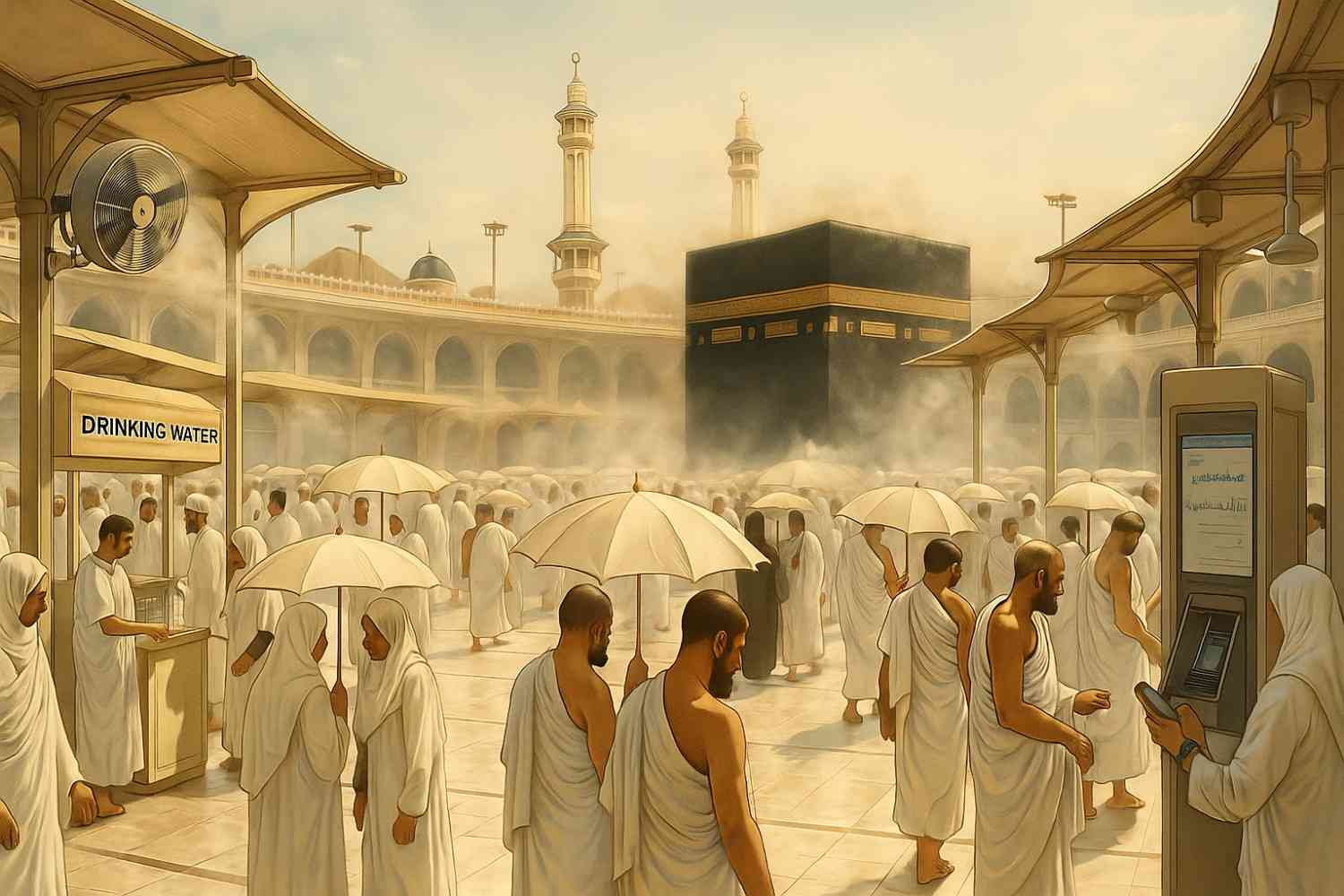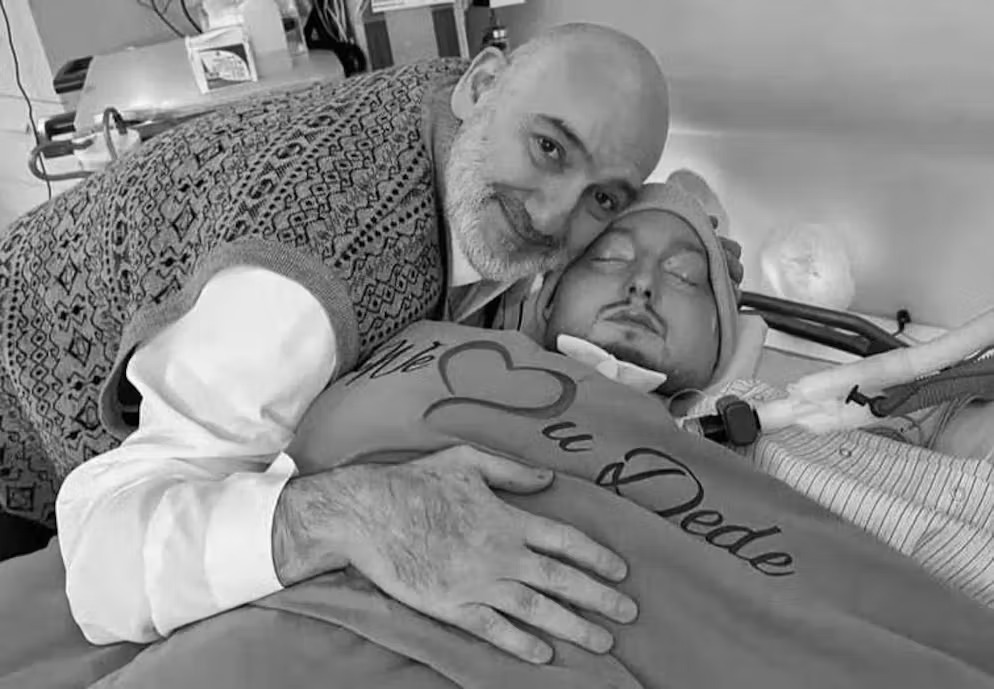There is always been a special challenge in summer at Makkah and Madinah because of the hot desert climate, but in 2025 times are just too hot: especially during the summer months. At temperatures exceeding 50 C, the health of millions of pilgrims performing Umrah and visiting the Prophet Mosque is at the national level. Increases in the temperature levels during the pilgrimage season have triggered emergency planning, intelligent systems, and heat safety measures that have to be followed in the Kingdom.
The Heat Reacts: A New Age of Preparedness
To these record-breaking conditions of summer, Saudi authorities have reacted with a mixture of strategies of technology, infrastructure works together with emergency preparedness. The management of pilgrimage no longer has the option of heat safety measures, but it is an imperative component of the management. Walking areas, cool areas, and water points have grown in pilgrimage routes. Guidelines have also been issued to the pilgrims to schedule their rituals to be carried out in cool hours of the day as well, which makes pilgrimage less harmful and more comfortable.
The Pilgrim Safety in Makkah and Madinah
The country has focused more attention in the holy cities to secure worshippers. In 2025, Makkah Madinah news is still highlighting the redesign of the two cities to accommodate safer movements of crowds and ability to withstand climatic conditions. New developments feature cooling areas with solar energy, the increase of medical stations and smart traffic control to assist in maintaining people safe and comfortable, even at the hottest time of the day.
The Emergence of Smart Pilgrim Services Saudi Arabia
Technology has come to form the core of Saudi Arabia religious tourism strategy. Smart pilgrim services Saudi Arabia has also been equipped with smart phone applications to enable pilgrims book mode of transport, less congested prayer areas and informational live alert on heat intensity. Such services are also included in the Kingdoms vision 2030 plan as these services are also used to direct pilgrim flows, traffic decongestion, and quick response in case of any emergency occurred in the case of the pilgrims due to the weather.
Smart Wearables and Tempology
Smart bracelets and applications that help keep a count of the number of steps, water needs and body temperature are being used by pilgrims now. These wearable technologies are connected to the health services that warn of medical groups in case one is at the risk of heat exhaustion or stroke. The merger of smart gadgets into the experience of pilgrimage is an innovative decision, which incorporates religious adherence and life-saving technology into a whole.
Chilled Out Technologies Recasting Pilgrimage
Chilling pavement, misting fans, shady tunnels and even climate-controlled tents are not an amenity anymore, they are a necessity. Makkah and Madinah have implemented thousands of cooling mechanisms in the areas of high density. The presented solutions make the rituals such as Tawaf, Sa i, walking long distances among sites be completed under considerable reductions in health risks. Sustainability in the use of these systems using solar energy also does not contribute to the burden to the environment.
Heat Management Infrastructure Upgrades
In Makkah, to cope with high temperatures during summer, huge infrastructure is constructed to shelter pilgrims against direct sunlight and hot surfaces. New covered walkways and shaded resting areas offer relief of the sun the whole day. In Madinah, it has doubled the courtyards and air-conditioned sides of Prophet Mosque where pilgrims can pray and have time to meditate.
Adjustments to Transportation Pilgrimage Safer
Transports are important in reducing the exposures to heat. Electric buses, trams and metro lines with high capacities run at increased frequency in Makkah and Madinah to transport pilgrims speedily and effectively during summer. Shuttle services, which are air-conditioned, are currently available 24hours between major locations, and hotels, thus minimising travel by foot, exposing the individual to extreme heat of the sun. Such services are made available where they are needed the most thanks to real-time tracking.
Heat Clinics and Emergency Services
There are mobile medical clinics placed at the periphery of every major pilgrimage site, with people getting immediate remedies in cases of dehydration, fatigue or sunstroke. In these clinics, there are IV hydration, cool blankets and rest areas. The emergency forces are trained in heat-related areas and more staff members have been employed to guarantee speedy efforts in the two cities during the peak summer seasons.
Education and Awareness Campaigns
The areas targeted include pilgrims who are being educated on the dangers of summer heat by means of online tutorials, airport reading materials, hotel conferences, and announcements in the mosques. Such awareness programs highlight on the issue of hydration, rest time and the symptoms of heat related illness. To enhance guidance on how to stay hydrated during summer, the Ministry of Hajj and Umrah has made provision that guidance is offered to the pilgrims in various languages and thus anyone can find it easy to give heed to safety instructions.
The Government and the Private Sectors In Cost Management
The coordination of preparations is being done by the private and the government sector of Saudi Arabia to help in proper management of peak summer in the city of Makkah and Madinah. The hotel operators have been advised to exercise high cooling standards. Tour operators must also add the heat safety briefings in their packages nowadays. The partnership with local technology companies is also what has contributed on the development of superior smart pilgrim services that are known in Saudi Arabia today throughout the world.
Increased Access to and Hydration Stations
Hydration is among the best ways of countering heat stress. Government agencies have also established more cold-water dispensing outlets near the Prophet Mosque as well as at the Grand Mosque. Automated systems have also been integrated in the distribution of Zamzam water such that pilgrims have an easy time, safely and hygienically refilling the bottles. These are some of the actions that facilitate easy hydration at any time and place.
Umrah 2025 Updates are Preparedness
The pilgrimage experience is modified in lines with the new changes of the Umrah 2025 with a special consideration to safety. The introduction of weather dependent permit systems can be granted to then particular times of the day only in the cooler hours. New regulations also stimulate distancing between pilgrims to come so that there is no overcrowding and over-exposure. Such updates are indicative of an increased knowledge of the need of climate and religion to co-exist in the part of contemporary pilgrimage planning.
The Evening service and Service Planning
Due to excessive temperatures during the day, additional rituals and other activities are being conducted after the setting of the sun. Pilgrims are advised not to do Tawaf and Sa i during day time because it is hot. The key spots of Makkah and Madinah are also kept illuminated with full maintenance during the night time which presents a spiritually enriched and safer atmosphere to the worshippers.
Pilgrimage Safety and Data and Artificial Intelligence
The use of artificial intelligence in providing safety in Umrah and other religious visits is on the increase. Algorithms are now being used to check the density of the crowd, to anticipate the points of congestion and adjust the flow of traffic on the fly. Weather monitoring is also connected to these systems to predict times of heat, and send the warning. Mobile and wearable devices provide authorities with data which informs them in real-time, guiding their decision-making process in the best possible way.
Special Services of Vulnerable Pilgrims
Individuals that are elderly pilgrims or suffer disabilities are especially vulnerable during extreme hot temperatures. Saudi Arabia has given special attention to special groups of people and has given them special services such as priority transport, VIP cooling lounges, and escort service. Senior-friendly Smart devices enable them to have contact with support teams. They undergo training of assisting them during movement and rituals as well, through volunteers.
Environmental Factors and Environmental Solutions
Sustainable development is inseparable with heat safety measures. Saudi Arabia is also spending its money on environmental friendly options which include solar energy and water recycling and even temperature controlling material used in building structures. Improved technologies have been incorporated in cooling systems to lower the electricity consumption but with high efficiency. Such inventions not only make the cities safer to pilgrims but also greener.
Future-fit Cities in the Holy Cities
Planning into the long term in Makkah and Madinah is considering the summer heat. Thermal insulation in buildings, heat-reflective surfaces, and rooftop gardens have become an addition to the future construction projects. The conventional redesigning of the public spaces involve the use of natural ventilation and shading. Such designs in future will also make sure that the two categories of people; the residents and the pilgrims will enjoy a better living environment throughout all seasons.
Pilgrim Apps Technological Empowerment
Pilgrimage mobile applications have transformed the way pilgrims relate with their environment. Users get up to date notifications through prayer times, change of route, weather alerts and service status through their apps. On maps designed as applications, the closest hydration stations, chill-out spots, and prayer shade are displayed. Even payment systems have gone online and pilgrims travel, eat and shop without carrying cash.
Volunteer and On Ground Team Role
Behind pilgrims, there are thousands of trained volunteers involved in the support activity during their stay. These people escort tourists to the secure areas, give out ice cold water and assist in case of an emergency. They give joy to pilgrims, who mostly are first time visitors of the holy cities. The availability of volunteers is currently being organized through the smart system to facilitate an adequate coverage and communication in real-time.
The Ongoing Safety Innovation Investment
The Kingdom is investing a lot in pilgrimage safety through the investment in technologies and the infrastructure. New generation crowd management and heat management solutions are being developed already. Clothing this smart, shelters which react to the climate and drones which will provide emergency services are being tested. Such inventions hold potential of revolutionizing religious tourism in a manner that would facilitate the combination of spiritual experience coupled with the finest safety provisions.
Conclusion: Makkah and Madinah Which Path to Follow
The summer of 2025 will give a signature to the process of management of mass pilgrimage in the era of climate change. Using ancient religious custom and developing with modern innovation, Makkah and Madinah are redefining the global trends that are shaping the heat-safe and smart services. With careful planning and technology these cities are demonstrating that faith can be respected and life can be preserved as the number of pilgrims is increasing every year.
The pilgrims now come prepared with spiritual as well as being safe in the knowledge that security systems are among the best in the world. The summer pilgrimage in Saudi Arabia is not only changing step by step, prayer by prayer, and innovation by innovation, but with enough improvements and effective communication, expressing caring, Saudi Arabia will ensure that Hajj is all about delighting its population with a successful experience.
For more insights on Saudi life, travel, and safety tips, stay connected with Know Saudi.




